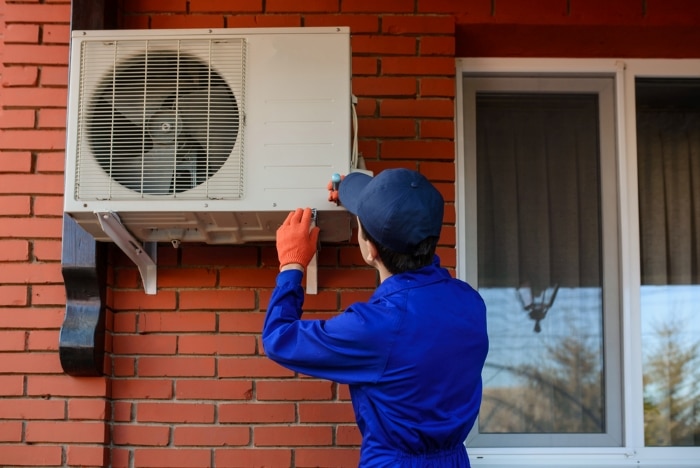We've independently reviewed this article to make sure it's as accurate as we can make it.
To find out more about our article creation and review process, check out our editorial guidelines.
Is your Window AC displaying an Error Code you’ve never seen before?
That sucks! Window Air Conditioners are essential to staying cool and fresh during hot days and sweltering summer months.
I understand how annoying it can be to have your Window Air Conditioner display an Error Code and have no idea what it means. But don’t worry; you’ve come to the right place for answers. Below, you’ll find a list including the most common Window AC error codes and simple fixes for each one.
Depending on your Window AC’s brand and model, you’ll likely encounter different Error Codes. The most common out there are “ES“, “E1/E4“, and “AS“. Keep a close eye on what your Window Air Conditioner displays to understand what each one means and what you can do about it.
Read on to get rid of the dreaded Error Codes!
Why trust us? This article was written by Craig Anderson and Alan Stephens.
Craig has helped thousands of other homeowners repair their appliances since 2016.
Alan is one of our resident appliance repair experts with over 20 years of experience in both commercial and residential HVAC projects. He has all 3 HVAC license certifications in North Carolina (H-1, H-2, & H-3-1). Since 2004, he runs his own company, Eco Green Air Inc in Raleigh, NC.
What Your Window AC’s Error Codes Mean
With so many Window AC manufacturers out there, there’s a need for different Error Codes to prevent mixups and general confusion, so the same Error Code can mean different things depending on your product’s brand.
Not to mention that since modern appliances are getting increasingly complex, new Error Codes must be created daily. Here are the most common Error Codes I’ve seen over the years in some of the most popular brands on the market.
Frigidaire
Frigidaire Window Air Conditioners are reliable and typically last a long time. However, when there’s an Error Code present, it’s critical to address it as soon as possible to get the appliance back to normal quickly. Here are the most common Error Codes you’re likely to encounter if you own an AC from Frigidaire.
ES Error Code
The “ES” Error Code in a Frigidaire Window Air Conditioner means that there’s an Evaporator temperature sensor failure. The evaporator within your Window Air Conditioner helps remove excess heat from your living spaces, delivering the cooling results you’re used to.
From what I’ve seen over the years, it’s not very common to have the evaporator temperature sensor fail unless the evaporator coils are dirty or damaged or there’s something loose in the Control Board; however, if you’re getting an “ES” Error Code, something’s not right.

Solution: The first thing I recommend you do is unplug your Window AC from the wall outlet or flip the switch delivering power to it from your circuit breaker. Carefully disassemble the appliance to access the evaporator coils and the Control Board, then:
- Ensure the evaporator coils are clean (you should clean the coils at least once every 3 months).
- Check the Control Board for any signs of damage.
- Ensure the evaporator temperature sensor wire is undamaged and properly connected to the Control Board.
You’ll need to replace the evaporator temperature sensor if there’s something wrong with it. Please get in touch with a certified HVAC technician you trust for a repair quotation or to have them help with the steps above if you feel unsafe at any point.
AS Error Code
Along with the evaporator temperature sensor, there’s another component called an air temperature sensor, which serves a similar purpose. If you’re seeing an “AS” Error Code on your Frigidaire Window AC, there’s a good chance that the air temperature sensor is failing.
To get to the bottom of the issue and attempt to repair the problem and stop the Error Code from showing up on your appliance’s display, you’ll need to look at the internal components closer.
Solution: Follow the same steps from the previous point to check your Control Board and the wiring from the air temperature sensor to the board. Look for any signs of damage on either one.
Every Window Air Conditioner is different, so if you’re unsure where the air temperature sensor is in yours, in many cases, you can find its specific location and wiring diagram in your User Manual. Provided you no longer have the manual handy, please refer to our free resource below.
If you determine the air temperature sensor needs repairing/replacing, you can either contact your manufacturer if you’re still under warranty coverage or ask your trusted technician for a quotation on a new sensor and the cost of labor to install it.
GE (General Electric)
General Electric products are everywhere. As you may know, the brand not only makes Window Air Conditioners but also refrigerators, washers, and several other appliances.
From what I’ve seen, as opposed to Frigidaire, GE product Error Codes typically start with the letter “E” (similar to LG, but we’ll get to that later). Here are the most common Error Codes you’ll find on GE Window Air Conditioners.
E1 Error Code
The E1 Error Code indicates a Control Board function failure. The Control Board inside any Window Air Conditioner acts as the appliance’s brain. Through the Control Board, your AC can communicate with its internal components, understand your commands, and adjust its settings according to what you’re dialing in.

Naturally, any failure with the board must be addressed as soon as possible to get your Window AC back to normal.
Solution: One of the simplest ways to address an E1 Error Code on a GE Window Air Conditioner is by unplugging it from the wall outlet or cutting off power to the appliance from your circuit breaker.
I’ve found that in many cases, the Error Code shows up due to a bug, so resetting electricity to the unit does the trick. However, if the Error Code is still present after restarting your Window Air Conditioner, please follow the previous points’ steps to thoroughly check the Control Board for signs of damage or burning, which can indicate a short circuit.
If you notice any damage to the component, you must replace it. Consider the cost of replacement carefully, as sometimes, replacing the Control Board alone can cost 50% or more of the price of a brand-new Window AC.
E4 Error Code
As a bonus, I’d like to include the E4 Error Code. The Error Code doesn’t apply to Window ACs but rather to portable models, so if you don’t own one, feel free to skip ahead. However, if you also have a portable AC, rest assured that the E4 Error Code only means the water bucket is full or the float switch (which helps the appliance measure water levels) is defective.
Luckily, both issues are easy to address, and portable AC float switches are relatively cheap.
Kenmore
Moving on to Kenmore, you’ll notice that this brand shares an Error Code with Frigidaire, indicating that while manufacturers often try to use different names, sometimes there’s no need to.
ES Error Code
Like Frigidaire, Kenmore also has an “ES” Error Code. In this particular scenario, the Error Code indicates the same issue as with Frigidaire models – an evaporator temperature sensor failure.
Solution: In my experience, the process to address the Error Code is very similar to Frigidaire Window ACs, but please ensure to check your User Manual for the right instructions and wiring diagrams, as those will vary from manufacturer to manufacturer.
AS Error Code
The next Error Code you’re likely to encounter on a Kenmore Window AC is “AS“, which, surprisingly enough, also shares its meaning with its Frigidaire counterpart. Air temperature sensor failures are quite common in Window ACs, so it makes sense that several manufacturers have the same name for it.
Solution: Repeat the process from the Frigidaire section of the same Error Code to address it. Just ensure to refer to your User Manual for the right wiring diagram and disassembly instructions.
LG
Last but not least, there’s LG. Like GE, LG has a wide range of models from various appliances, so they have a library’s worth of Error Codes to help users understand what’s wrong with their units.
E1 Error Code
Let’s start off with the “E1” Error Code. The E1 Error Code indicates a problem with the Window AC’s temperature sensor. The temperature sensor is critical to your appliance’s functionality, as the component is responsible for detecting ambient temperature and adjusting its settings to deliver the temperature you’ve dialed in.
Solution: Checking your LG Window AC’s temperature sensor is very easy.
- Unplug the appliance from the wall outlet or kill power to it from your circuit breaker.
- Carefully disassemble the unit to gain access to the Control Board.
- Check for any signs of damage, such as breakage or burning from short-circuiting.
- Ensure all cables are properly attached to the Control Board.
If you’re unsure where your temperature sensor is and what wire belongs to it, your User Manual likely has a wiring diagram you can refer to. If you suspect the temperature sensor is faulty or damaged, you must replace it to get things back to normal.
E2 Error Code
Moving on, let’s now discuss the “E2” Error Code. The E2 Error Code on your LG Window AC normally indicates failure/short circuit in the indoor pipe temperature sensor. Like the temperature sensor, the indoor temperature sensor also measures how hot or cold an area is; however, this sensor is more specific, and some versions can also detect humidity.
Solution: The process of checking and replacing an indoor temperature sensor is virtually the same as that of a regular temperature sensor.
Please get in touch with a technician if you’re ever unsure about any part of the process.
E3 Error Code
Refrigerant issues are no joke – especially when it comes to Window ACs. An “E3” Error Code in an LG Window AC typically indicates that the unit has detected there’s no refrigerant inside it or not enough to work normally.

Solution: Refrigerant refilling is a complex process that can damage your Window AC permanently and put you at risk if done wrong. My recommendation is to call a technician you trust and let them handle the job.
E4 Error Code
As with GE, I’d like to add Error Code E4 as a bonus for people who own both Window ACs and portable ACs. An “E4” Error Code is exclusive to Portable Air Conditioners, and it indicates the unit is in defrost mode.
Typically, your Portable AC will enter defrost mode when it detects ice on the evaporator, which is located behind the front grille. Once the evaporator has fully defrosted, the Air Conditioner will return to working normally.
Solution: There’s not much to do here; sit tight and be patient. If you want to be proactive, you can try to figure out what’s causing excess frosting to prevent further issues in the future.
Addressing Your Window AC’s Error Codes
That about covers it!
When you’re trying to figure out what the most common Window AC Error Codes are, you can learn a lot, but often finding the right information is tricky.
I hope this piece has helped you better understand what the most common AC Error Codes mean and what you can do to address them. More often than not, all you have to do to get things back to normal is restart the AC or replace an internal component.
Thanks for reading. If this article was useful and answered your most burning questions, please check out our other resources and free guides below and consider subscribing to our newsletter.
Have a great week!
-Craig.









